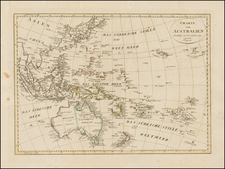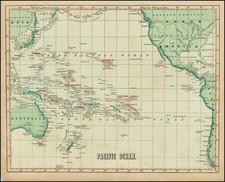Finely executed chart of Sandalwood Bay from the United States Exploring Expedition's scientific exploration of the Pacific Ocean conducted by the United States from 1838 to 1842.
The sea chart depicts the topography of the bay, including the depth of the water, the location of reefs, and the position of rocks and shoals. The chart also shows the shoreline and the surrounding vegetation, including the locations of sandalwood trees, which were a valuable commodity at the time.
The sea chart provides a valuable insight into the geographic and ecological features of Sandalwood Bay and the wider Fiji group of islands. The Wilkes Expedition was one of the first scientific expeditions to document the Pacific Islands, and the sea chart is a testament to the meticulous scientific observations made by the expedition's members.
The United States Exploring Expedition, also known as the Wilkes Expedition, was a major scientific and exploration endeavor conducted between 1838 and 1842. The expedition aimed to explore the Pacific Ocean and its surrounding lands, mapping uncharted regions and gathering scientific data. The expedition's findings significantly contributed to the understanding of Pacific geography, natural history, and cultural anthropology at the time. The maps on this chart are a testament to the meticulous work carried out by the US Ex Ex during their exploration of the Fiji group.
After publication of the initial report and small group of maps, a number of subsequent reports, maps and plate were issued over the next several decades. This map was issued in one of the two volumes issued in 1850 and 1858:
United States Exploring Expedition. During the Years 1838,1839,1840,1841,1842. Under the Command of Charles Wilkes, U.S.N. Atlas of Charts. VOL. I. and VOL. II From the Surveys of the Expedition. By Authority of Congress. Philadelphia C. [onger] Sherman, printer. 1850.
Volume 1 was issued in 1850 as a bound volume of 55 unnumbered charts.
Volume II was issued in 1858 as a bound volume of 51 numbered charts.
The charts were also sold seperately.
Charles Wilkes (1798-1877) was a skilled naval surveyor and the commander of the United States South Seas Exploration Expedition (U.S. Ex. Ex.), the largest scientific voyage ever mounted by the United States. Wilkes was born in New York City and began to sail in merchant vessels from 1815-1917.
Wilkes joined the United States Navy as a midshipman in 1818; by 1826, he had risen to the rank of lieutenant. Fascinated by hydrography, Wilkes studied triangulation and surveying with Ferdinand Hassler, the first superintendent of the United States Coast Survey. This expertise and initiative led him to be named Director of the Navy’s Depot of Charts and Instruments in 1833.
After being stalled by the Navy, U.S. Ex. Ex.—the U.S. response to the scientific voyages of Cook and La Perouse—was finally preparing to sail in the late 1830s. Wilkes was offered command, thanks to the heavy surveying focus on the voyage. He was given command of six vessels and nine scientists. However, the ships were not well supplied and the expedition was executed with some difficulty.
The ships left Norfolk in August 1838. They went in convoy to Tierra del Fuego, where they split and some explored in the South Seas and others in the South Atlantic. In late 1830, Wilkes surveyed portions of Antarctica that today are named for him (Wilkes Land). From spring 1840, the ships explored the mid- and North-Pacific. In June 1842, Wilkes returned to New York Harbor with only two of his six ships and a mountain of ethnographic, botanical, and natural historical specimens, as well as reams of observations, drawings, and charts.
Wilkes was met with a court martial; while he was acquitted of most charges, he was convicted of illegal punishment and reprimanded by the Secretary of the Navy. Despite this, he was promoted commander in 1843, captain in 1855, and commodore in 1862.
Wilkes spent much of his remaining career overseeing the publications of the expedition. The first official publication to appear was Wilkes’ rambling five-volume narrative of the voyage, accompanied by a folio atlas, in 1844. A further 19 volumes were prepared over the course of 30 years, each on a different scientific topic, although only 14 were ever distributed. Perhaps the most impressive legacies of the expedition were the almost 250 charts Wilkes prepared in two atlases (completed 1858, published 1861, but not distributed until after the Civil War). These formed the basis of the United States Hydrographic Office.
Wilkes served in the Union fleet in the Civil War. In 1864 he was before a court-martial again, this time for the publication of a private letter to the Secretary of the Navy. He was found guilty. He retired two years later, in 1866, and died in Washington D. C. in 1877.









![[Straits of Le Maire, Nova Guinea, South Pacific]](https://storage.googleapis.com/raremaps/img/small/61345op.jpg)
![[Cook's Route through New Caledonia and New Hebrides] Carta delle scoperte fatte nel mar Pacifico sopra il Vascello la Resolution, Comandata dal Capitano Cook, nel 1774](https://storage.googleapis.com/raremaps/img/small/91872.jpg)

![[ Australia & New Zealand ] La Nuova Guinea e Nuova Galles](https://storage.googleapis.com/raremaps/img/small/86442.jpg)

